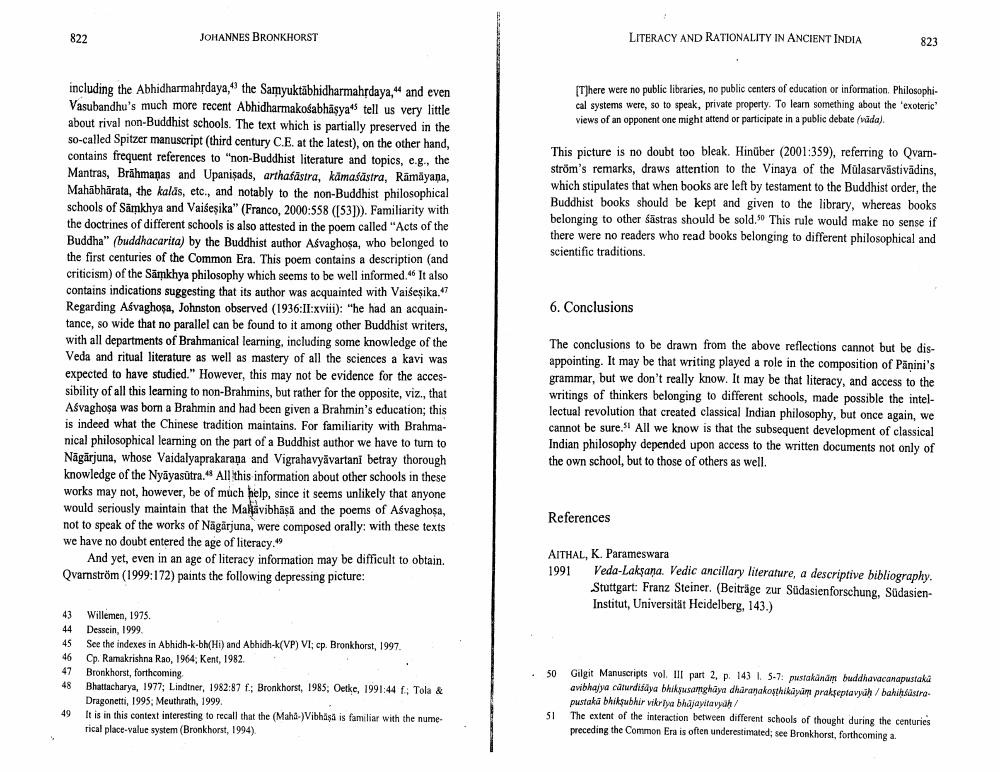________________
JOHANNES BRONKHORST
LITERACY AND RATIONALITY IN ANCIENT INDIA
823
[T]here were no public libraries, no public centers of education or information Philosophical systems were, so to speak, private property. To learn something about the exoteric views of an opponent one might attend or participate in a public debate (näda).
This picture is no doubt too bleak. Hinüber (2001:359), referring to Qvamström's remarks, draws attention to the Vinaya of the Malasarvistivadins, which stipulates that when books are left by testament to the Buddhist order, the Buddhist books should be kept and given to the library, whereas books belonging to other sästras should be sold. This rule would make no sense if there were no readers who read books belonging to different philosophical and scientific traditions
6. Conclusions
including the Abhidharmahrdaya," the Samyuktābhidharmahrdaya," and even Vasubandhu's much more recent Abhidharmakosabhäsya" tell us very little about rival non-Buddhist schools. The text which is partially preserved in the so-called Spitzer manuscript (third century C.E. at the latest), on the other hand, contains frequent references to "non-Buddhist literature and topics, e.g., the Mantras, Brāhmaṇas and Upanişads, arthafästra, kamasastra, Ramayana, Mahābhārata, the kalds, etc., and notably to the non-Buddhist philosophical schools of Sāmkhya and Vaišeşika" (Franco, 2000:558 ([53)). Familiarity with the doctrines of different schools is also attested in the poem called "Acts of the Buddha" (buddhacarita) by the Buddhist author Asvaghosa, who belonged to the first centuries of the Common Era. This poem contains a description and criticism) of the Samkhya philosophy which seems to be well informed. It also contains indications suggesting that its author was acquainted with Vaišesika." Regarding Ašvaghosa, Johnston observed (1936:II:xviii): "he had an acquain. tance, so wide that no parallel can be found to it among other Buddhist writers, with all departments of Brahmanical learning, including some knowledge of the Veda and ritual literature as well as mastery of all the sciences a kavi was expected to have studied." However, this may not be evidence for the accessibility of all this learning to non-Brahmins, but rather for the opposite, viz., that Ašvaghoșa was born a Brahmin and had been given a Brahmin's education; th is indeed what the Chinese tradition maintains. For familiarity with Brahmanical philosophical learning on the part of a Buddhist author we have to turn to Nägärjuna, whose Vaidalyaprakarana and Vigrahavyävartani betray thorough knowledge of the Nyāyasutra." All this information about other schools in these works may not, however, be of much help, since it seems unlikely that anyone would seriously maintain that the Malavibhāṣā and the poems of Asvaghosa, not to speak of the works of Nagarjuna, were composed orally, with these texts we have no doubt entered the age of literacy."
And yet, even in an age of literacy information may be difficult to obtain. Qvarnström (1999:172) paints the following depressing picture:
The conclusions to be drawn from the above reflections cannot but be disappointing. It may be that writing played a role in the composition of Paņini's grammar, but we don't really know. It may be that literacy, and access to the writings of thinkers belonging to different schools, made possible the intellectual revolution that created classical Indian philosophy, but once again, we cannot be sure. All we know is that the subsequent development of classical Indian philosophy depended upon access to the written documents not only of the own school, but to those of others as well.
References
AITHAL, K. Parameswara 1991 Veda-Laksana. Vedic ancillary literature, a descriptive bibliography,
Stuttgart: Franz Steiner. (Beiträge zur Südasienforschung, SüdasienInstitut, Universität Heidelberg, 143.)
43 44 45 46 47 48
Willemen, 1975. Dessin, 1999 See the indexes in Abhidh-k-bh(Hi) and Abhidh-k(VP) VI: cp. Bronkhorst, 1997 Cp. Ramakrishna Rao, 1964; Kent, 1982 Bronkhorst, forthcoming Bhattacharya, 1977, Lindtner, 1982:87 f: Bronkhorst, 1985, Oetke, 1991:44 ; Tola & Dragonetti, 1995: Meuthrath, 1999. It is in this context interesting to recall that the (Maha-) Vibhasa is familiar with the numerical place-value system (Bronkhorst, 1994)
50
Gilgit Manuscripts vol. III part 2, p. 143 I. 5-7 pustand buddhawacanapustaki avibhajya cludiya bhikṣusamghaya dharanakothikayum prakseptavih / bahistro pustaka bhiksubhir vikiye bhujayitah The extent of the interaction between different schools of thought during the centuries preceding the Common Era is often underestimated; see Bronkhorst, forthcoming a
51




